The Image, History, and Meaning of Escrava Anastácia
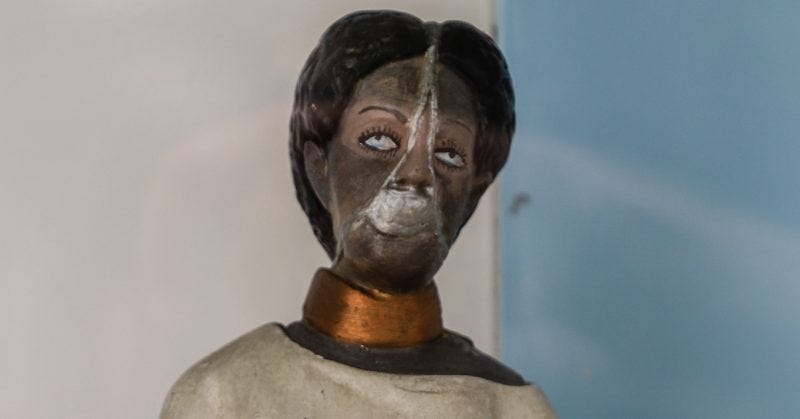
Roberto Strongman published this brilliant article on on November 4, 2021. He is a modern social sciences academic, so he writes using their unintelligible style. He gave me permission to translate and publish his valuable contribution into English. If you want to read it in its original form, see HERE. Any mistakes or misinterpretations are mine alone.
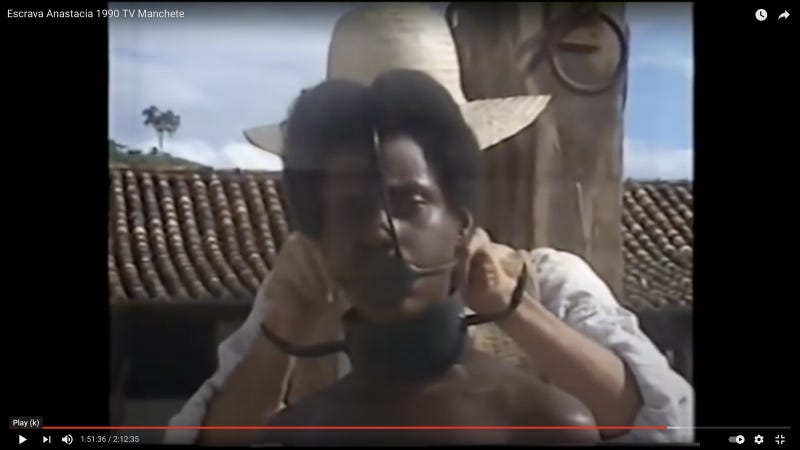
Here she is at the pillory in the 1990 Brazilian mini-series “Escrava Anastásia”
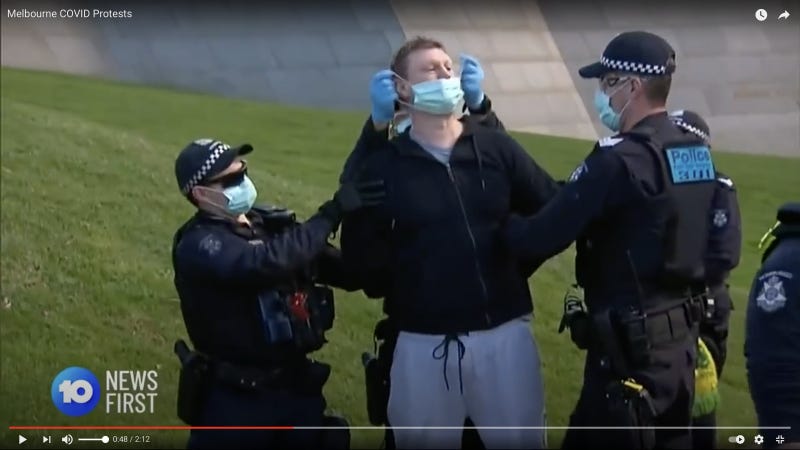
Anti-lockdown protester in Melbourne, Australia in 2020.
Escrava Anastácia was a folk saint in Brazil. She is venerated by many black Brazilian Catholics and has a shrine in the Church of Our Lady of the Rosary of Black People in Salvador da Bahia. She has never been acknowledged or canonized by the Roman Catholic Church.
Anastácia was punished, silenced, and likely raped by a slave owner. In some versions of the story, the mistress of the plantation muzzles Anastásia to save herself from the public shame of her husband’s infidelity. In others, the reasons for her muzzling are the aid she provided to a runaway slave and her leadership in organizing a slave revolt.
The muzzling was a deterrent for others who might be inspired by Anastásia. She died either of starvation or of tetanus from the metal rusting in her mouth.
Her legend was that she could perform miracles even while muzzled. She was said to heal her oppressors. Her compassion towards her persecutors and her possible mixed-race background are thought by many to be a hopeful sign of racial reconciliation in Brazil and other slaveholding countries.
Anastásia’s ghost is seen at anti-lockdown rallies and her memory reveals that the current medical tyranny is enslavement. The masking of well people has no rational basis—over 200 studies refute its efficacy.
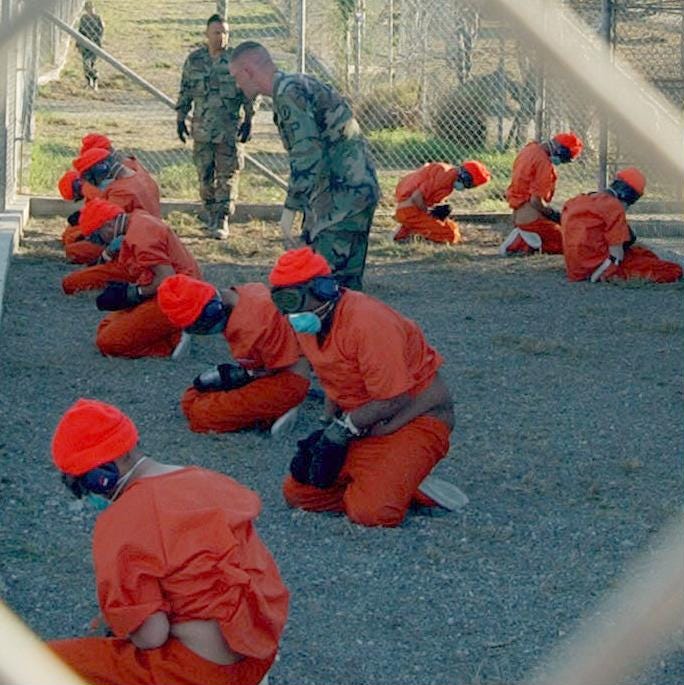
Some of today’s psychologists are mask advocates. Susan Michie, for example, claims that we will be wearing masks forever (Stone 2021).
Mandatory face masks are slave symbols:
- Masking imposes control and breaks down psyches, dignity, and integrity.
- They are symbols of submission, forced compliance, and arbitrary rules.
- They make it harder to breathe. This makes people more susceptible to brainwashing.
- Face masks are involved in bondage and sado-masochism. This is a master-slave dynamic.
- Masks are a feature of prisons and torture. Examples include the hoods on the Abu Ghraib prison victims and the mouth covers at Guantánamo. These people are dehumanized.
- Masking is a nameless, enforced uniformity that erases individual personhood.
- Masks are theatrical. They conceal our identities, rendering us alien to others and ourselves.
- Masks are a forced resocialization into the “new normal.” The more we accept this enslavement ritual, the harder it will be to regain our independence.
- The masks are state insignia. They are a visible display of allegiance to the system of medicalizing technocratic control. They are similar to the red neckerchiefs of the communist pioneer youth movement, which were a public profession of loyalty to the party and the supreme leader. Mao’s idea of “right thinking” has found new life in today’s America.
- The absence of facial expression with masking inhibits the non-verbal communication necessary for social organization that might lead to revolt.
- Masks are verbal muzzling that reduces communication. Their usage is isolating. Similar effects are caused by social distancing.
- Masks are used to train animals. They are symbols of dehumanization.
- Masks are just a a few steps away from shots, vaccine passports, and implantable monitoring devices.
- Every mask is a billboard for fear and a state of emergency. We are being subjugated with scaremongering, which is eroding our civil liberties.
- Masks make your neighbor a nameless disease vector instead of a friend and ally. Masks divide and conquer.
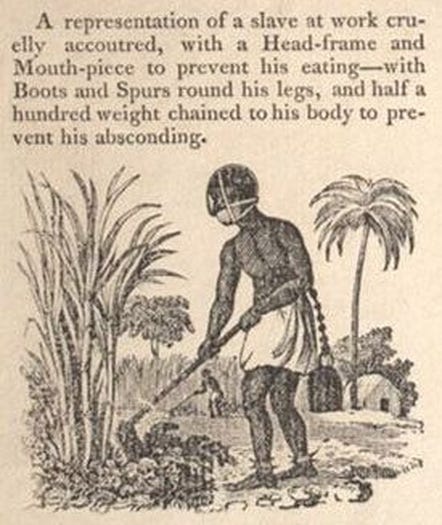
Can the memory of Anastásia overcome the Covidian cult? Her image is a powerful religious ritual and spectacle. For those of us in the freedom movement who are spiritual, our visions of Anastásia can give us faith.
Balls, chains, and shackles were iron, but in our technological age the bonds are fragile symbols such as paper masks. Yet they are potentially more brutal and confining than the old ones. Slavery is with us still.
Those who cannot or refuse to see masks and the rest of the modern era’s indignities as enslavement are hypnotized. If they realize what is happening, they lose face, which is embarrassing and painful.
Many people on both sides of the Atlantic who lived in the preindustrial and even Civil War times believed slavery was natural. Today, people are brainwashed into accepting endless, medicalized confinements and inconveniences using a variety of control techniques.
How many times have we heard the “new normies” decry the excesses of illegal mass gatherings and the so called super-spreader events as the reason for curtailing our civil liberties? They believe that we deserve lockdowns and that we have brought the situation on ourselves by not cooperating with “science.” Guilt is being weaponized.
The Spanish word “bozal” has two meanings: a muzzle and a newly arrived slave. This is a slave born in Africa and not a “creole” born in the New World. The muzzle devices were used on bozal slaves who had memories of freedom from their homeland. They were the ones most likely to lead rebellions, as the stories about Anastásia show.
The mask is an enslavement symbol, and Anastásia’s message is for us all.
Source – https://robertyoho.substack.com/p/dff151f1-2e2f-4b9b-875d-3fd8f4a5a99a#details
